Exploring Travel and Tourism: Developments, Types, and Destinations
VerifiedAdded on 2024/05/20
|14
|3633
|356
Report
AI Summary
This report provides a comprehensive overview of the fundamentals of travel and tourism. It begins by outlining the historical and current developments in the tourism sector, differentiating between mass and special interest tourism, and providing relevant examples. The report then discusses the reasons why tourists visit specific destinations, referencing literature on tourism demand, tourist behavior, and motivations, including push and pull factors and tourist typologies proposed by Plog, Cohen, and Gray. Furthermore, it examines the elements crucial for developing a new tourist destination, focusing on the 6A’s (attractions, access, activities, ancillary services, accommodation, and amenities). Finally, the report identifies and outlines the key organizations involved in the tourism supply chain within the private, public, and voluntary sectors of the UK travel and tourism industry.
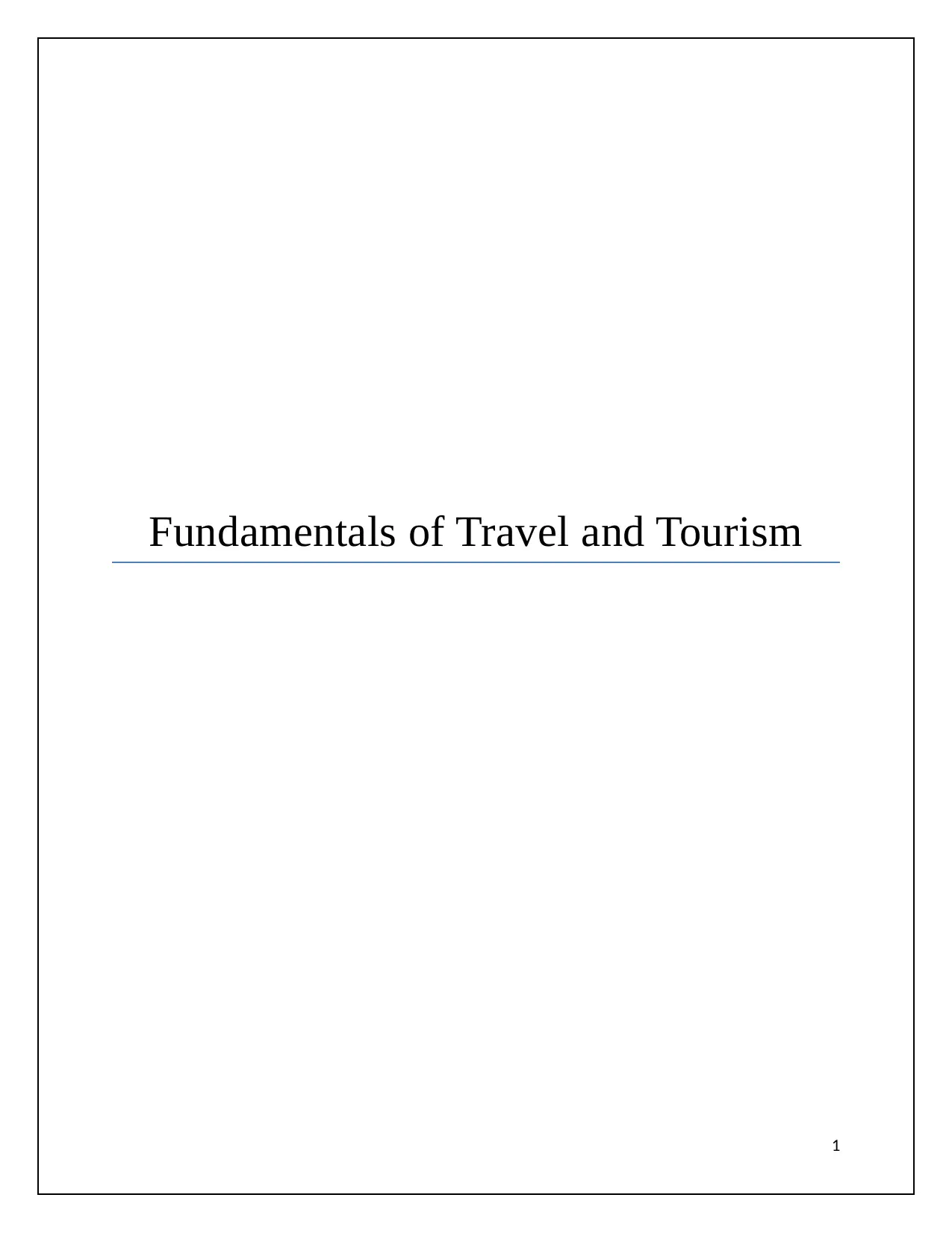
Fundamentals of Travel and Tourism
1
1
Paraphrase This Document
Need a fresh take? Get an instant paraphrase of this document with our AI Paraphraser
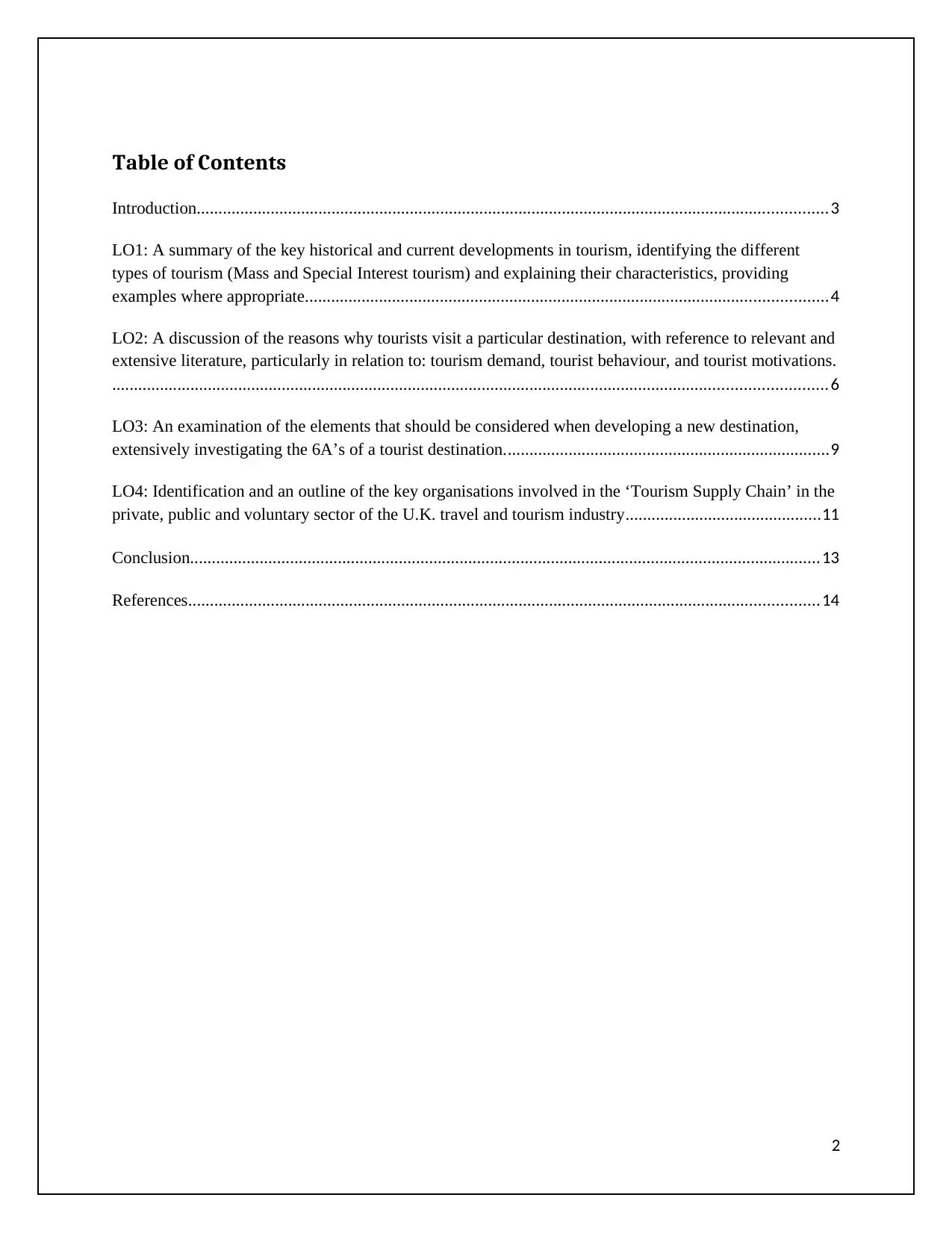
Table of Contents
Introduction.................................................................................................................................................3
LO1: A summary of the key historical and current developments in tourism, identifying the different
types of tourism (Mass and Special Interest tourism) and explaining their characteristics, providing
examples where appropriate........................................................................................................................4
LO2: A discussion of the reasons why tourists visit a particular destination, with reference to relevant and
extensive literature, particularly in relation to: tourism demand, tourist behaviour, and tourist motivations.
.................................................................................................................................................................... 6
LO3: An examination of the elements that should be considered when developing a new destination,
extensively investigating the 6A’s of a tourist destination...........................................................................9
LO4: Identification and an outline of the key organisations involved in the ‘Tourism Supply Chain’ in the
private, public and voluntary sector of the U.K. travel and tourism industry.............................................11
Conclusion.................................................................................................................................................13
References.................................................................................................................................................14
2
Introduction.................................................................................................................................................3
LO1: A summary of the key historical and current developments in tourism, identifying the different
types of tourism (Mass and Special Interest tourism) and explaining their characteristics, providing
examples where appropriate........................................................................................................................4
LO2: A discussion of the reasons why tourists visit a particular destination, with reference to relevant and
extensive literature, particularly in relation to: tourism demand, tourist behaviour, and tourist motivations.
.................................................................................................................................................................... 6
LO3: An examination of the elements that should be considered when developing a new destination,
extensively investigating the 6A’s of a tourist destination...........................................................................9
LO4: Identification and an outline of the key organisations involved in the ‘Tourism Supply Chain’ in the
private, public and voluntary sector of the U.K. travel and tourism industry.............................................11
Conclusion.................................................................................................................................................13
References.................................................................................................................................................14
2
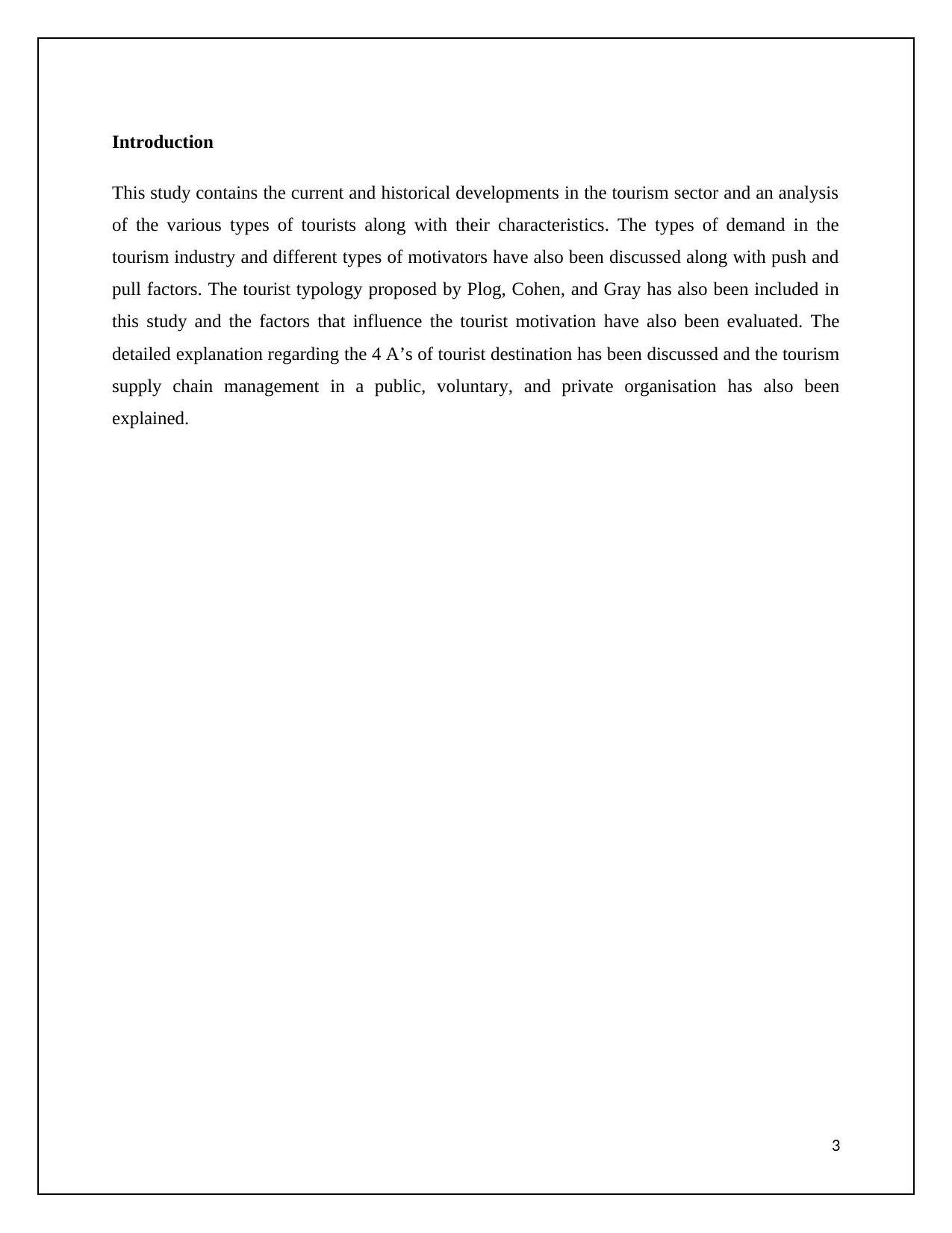
Introduction
This study contains the current and historical developments in the tourism sector and an analysis
of the various types of tourists along with their characteristics. The types of demand in the
tourism industry and different types of motivators have also been discussed along with push and
pull factors. The tourist typology proposed by Plog, Cohen, and Gray has also been included in
this study and the factors that influence the tourist motivation have also been evaluated. The
detailed explanation regarding the 4 A’s of tourist destination has been discussed and the tourism
supply chain management in a public, voluntary, and private organisation has also been
explained.
3
This study contains the current and historical developments in the tourism sector and an analysis
of the various types of tourists along with their characteristics. The types of demand in the
tourism industry and different types of motivators have also been discussed along with push and
pull factors. The tourist typology proposed by Plog, Cohen, and Gray has also been included in
this study and the factors that influence the tourist motivation have also been evaluated. The
detailed explanation regarding the 4 A’s of tourist destination has been discussed and the tourism
supply chain management in a public, voluntary, and private organisation has also been
explained.
3
⊘ This is a preview!⊘
Do you want full access?
Subscribe today to unlock all pages.

Trusted by 1+ million students worldwide
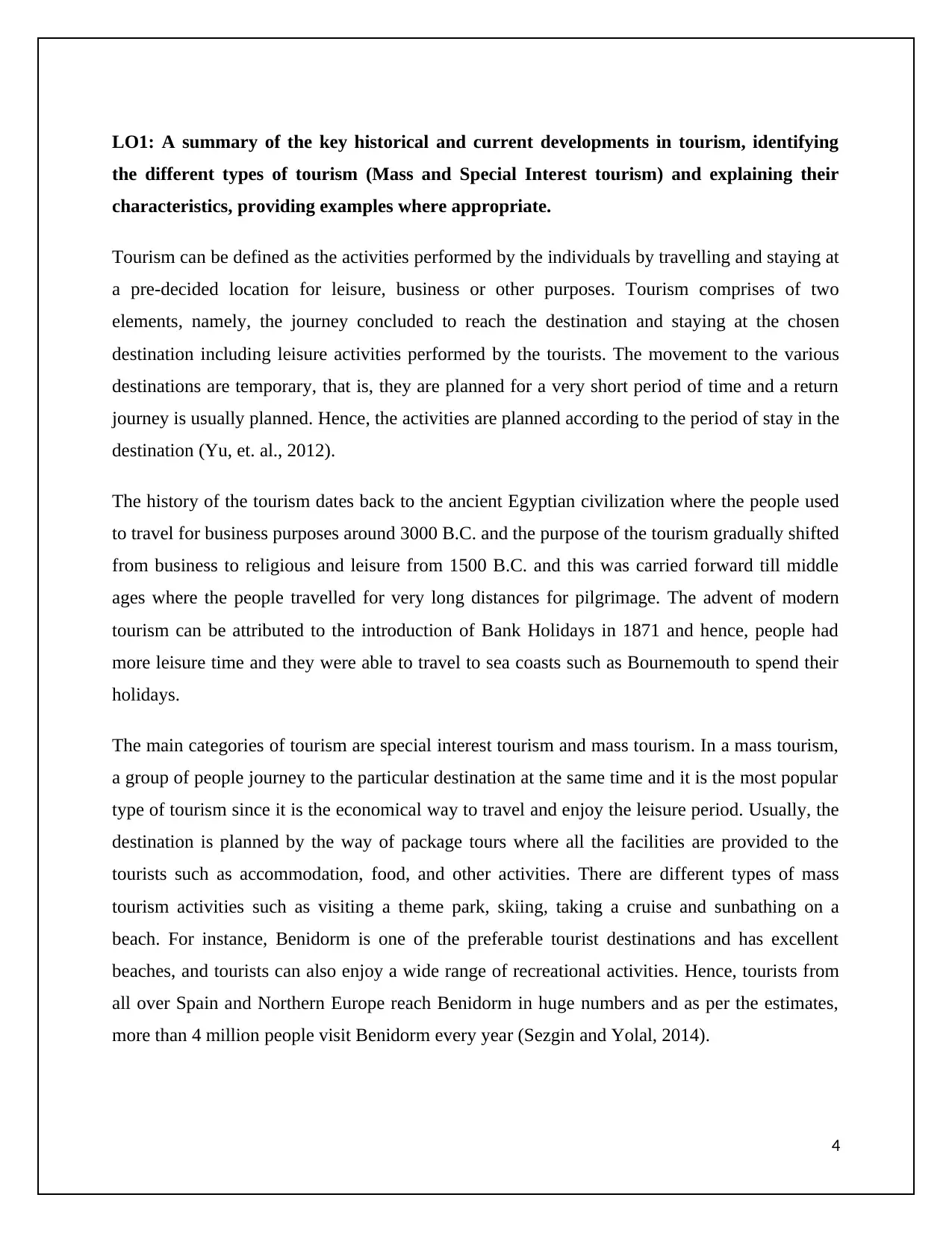
LO1: A summary of the key historical and current developments in tourism, identifying
the different types of tourism (Mass and Special Interest tourism) and explaining their
characteristics, providing examples where appropriate.
Tourism can be defined as the activities performed by the individuals by travelling and staying at
a pre-decided location for leisure, business or other purposes. Tourism comprises of two
elements, namely, the journey concluded to reach the destination and staying at the chosen
destination including leisure activities performed by the tourists. The movement to the various
destinations are temporary, that is, they are planned for a very short period of time and a return
journey is usually planned. Hence, the activities are planned according to the period of stay in the
destination (Yu, et. al., 2012).
The history of the tourism dates back to the ancient Egyptian civilization where the people used
to travel for business purposes around 3000 B.C. and the purpose of the tourism gradually shifted
from business to religious and leisure from 1500 B.C. and this was carried forward till middle
ages where the people travelled for very long distances for pilgrimage. The advent of modern
tourism can be attributed to the introduction of Bank Holidays in 1871 and hence, people had
more leisure time and they were able to travel to sea coasts such as Bournemouth to spend their
holidays.
The main categories of tourism are special interest tourism and mass tourism. In a mass tourism,
a group of people journey to the particular destination at the same time and it is the most popular
type of tourism since it is the economical way to travel and enjoy the leisure period. Usually, the
destination is planned by the way of package tours where all the facilities are provided to the
tourists such as accommodation, food, and other activities. There are different types of mass
tourism activities such as visiting a theme park, skiing, taking a cruise and sunbathing on a
beach. For instance, Benidorm is one of the preferable tourist destinations and has excellent
beaches, and tourists can also enjoy a wide range of recreational activities. Hence, tourists from
all over Spain and Northern Europe reach Benidorm in huge numbers and as per the estimates,
more than 4 million people visit Benidorm every year (Sezgin and Yolal, 2014).
4
the different types of tourism (Mass and Special Interest tourism) and explaining their
characteristics, providing examples where appropriate.
Tourism can be defined as the activities performed by the individuals by travelling and staying at
a pre-decided location for leisure, business or other purposes. Tourism comprises of two
elements, namely, the journey concluded to reach the destination and staying at the chosen
destination including leisure activities performed by the tourists. The movement to the various
destinations are temporary, that is, they are planned for a very short period of time and a return
journey is usually planned. Hence, the activities are planned according to the period of stay in the
destination (Yu, et. al., 2012).
The history of the tourism dates back to the ancient Egyptian civilization where the people used
to travel for business purposes around 3000 B.C. and the purpose of the tourism gradually shifted
from business to religious and leisure from 1500 B.C. and this was carried forward till middle
ages where the people travelled for very long distances for pilgrimage. The advent of modern
tourism can be attributed to the introduction of Bank Holidays in 1871 and hence, people had
more leisure time and they were able to travel to sea coasts such as Bournemouth to spend their
holidays.
The main categories of tourism are special interest tourism and mass tourism. In a mass tourism,
a group of people journey to the particular destination at the same time and it is the most popular
type of tourism since it is the economical way to travel and enjoy the leisure period. Usually, the
destination is planned by the way of package tours where all the facilities are provided to the
tourists such as accommodation, food, and other activities. There are different types of mass
tourism activities such as visiting a theme park, skiing, taking a cruise and sunbathing on a
beach. For instance, Benidorm is one of the preferable tourist destinations and has excellent
beaches, and tourists can also enjoy a wide range of recreational activities. Hence, tourists from
all over Spain and Northern Europe reach Benidorm in huge numbers and as per the estimates,
more than 4 million people visit Benidorm every year (Sezgin and Yolal, 2014).
4
Paraphrase This Document
Need a fresh take? Get an instant paraphrase of this document with our AI Paraphraser
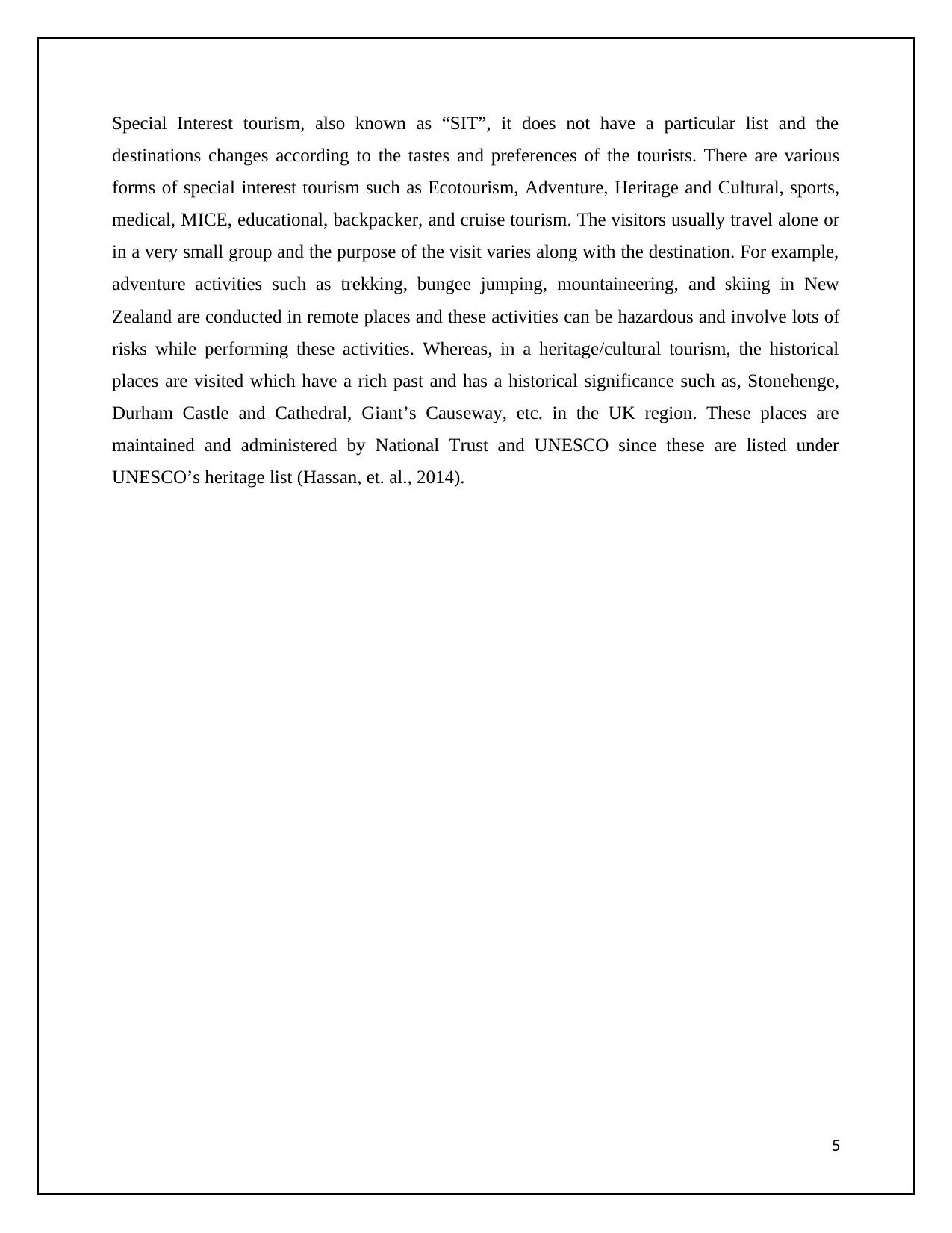
Special Interest tourism, also known as “SIT”, it does not have a particular list and the
destinations changes according to the tastes and preferences of the tourists. There are various
forms of special interest tourism such as Ecotourism, Adventure, Heritage and Cultural, sports,
medical, MICE, educational, backpacker, and cruise tourism. The visitors usually travel alone or
in a very small group and the purpose of the visit varies along with the destination. For example,
adventure activities such as trekking, bungee jumping, mountaineering, and skiing in New
Zealand are conducted in remote places and these activities can be hazardous and involve lots of
risks while performing these activities. Whereas, in a heritage/cultural tourism, the historical
places are visited which have a rich past and has a historical significance such as, Stonehenge,
Durham Castle and Cathedral, Giant’s Causeway, etc. in the UK region. These places are
maintained and administered by National Trust and UNESCO since these are listed under
UNESCO’s heritage list (Hassan, et. al., 2014).
5
destinations changes according to the tastes and preferences of the tourists. There are various
forms of special interest tourism such as Ecotourism, Adventure, Heritage and Cultural, sports,
medical, MICE, educational, backpacker, and cruise tourism. The visitors usually travel alone or
in a very small group and the purpose of the visit varies along with the destination. For example,
adventure activities such as trekking, bungee jumping, mountaineering, and skiing in New
Zealand are conducted in remote places and these activities can be hazardous and involve lots of
risks while performing these activities. Whereas, in a heritage/cultural tourism, the historical
places are visited which have a rich past and has a historical significance such as, Stonehenge,
Durham Castle and Cathedral, Giant’s Causeway, etc. in the UK region. These places are
maintained and administered by National Trust and UNESCO since these are listed under
UNESCO’s heritage list (Hassan, et. al., 2014).
5
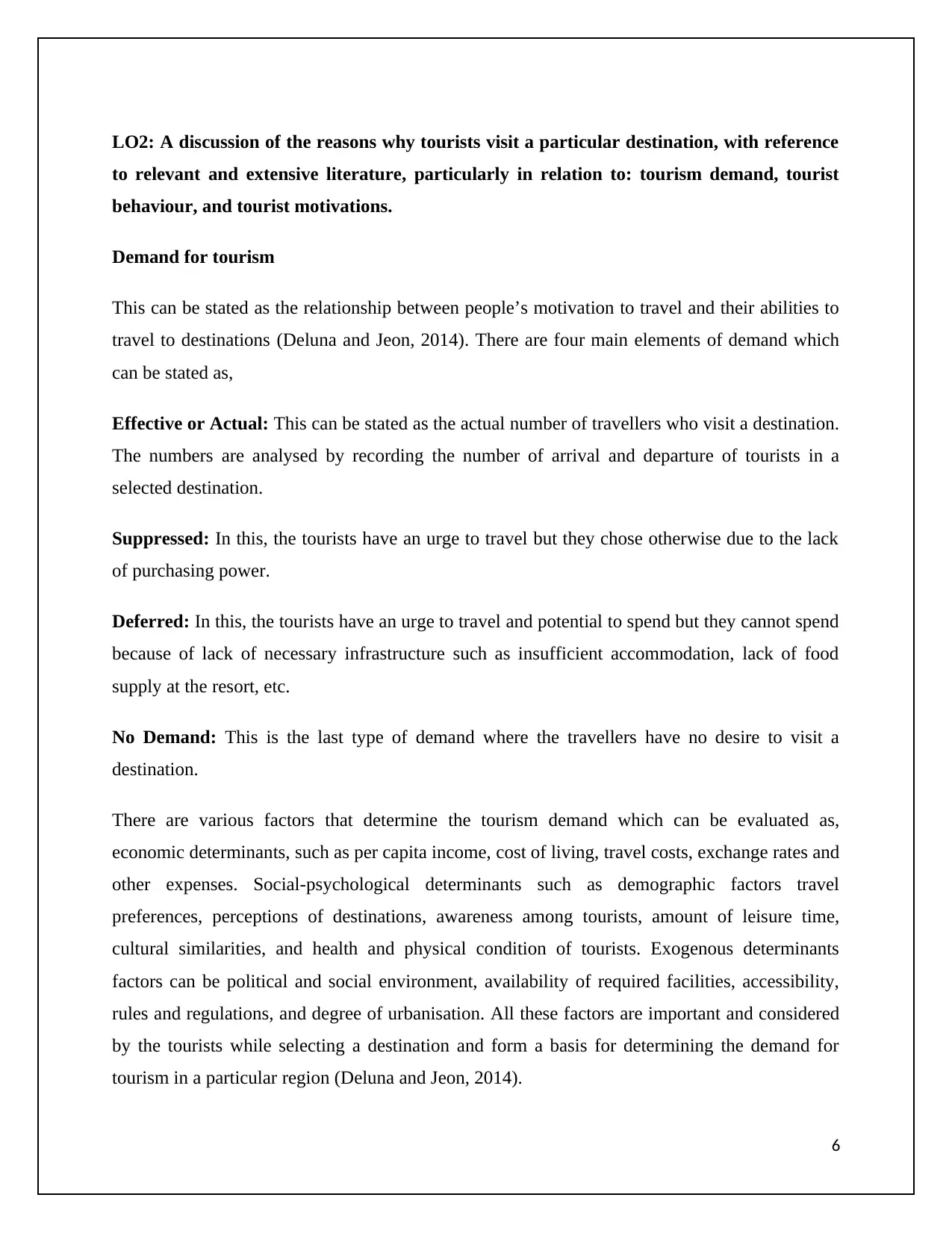
LO2: A discussion of the reasons why tourists visit a particular destination, with reference
to relevant and extensive literature, particularly in relation to: tourism demand, tourist
behaviour, and tourist motivations.
Demand for tourism
This can be stated as the relationship between people’s motivation to travel and their abilities to
travel to destinations (Deluna and Jeon, 2014). There are four main elements of demand which
can be stated as,
Effective or Actual: This can be stated as the actual number of travellers who visit a destination.
The numbers are analysed by recording the number of arrival and departure of tourists in a
selected destination.
Suppressed: In this, the tourists have an urge to travel but they chose otherwise due to the lack
of purchasing power.
Deferred: In this, the tourists have an urge to travel and potential to spend but they cannot spend
because of lack of necessary infrastructure such as insufficient accommodation, lack of food
supply at the resort, etc.
No Demand: This is the last type of demand where the travellers have no desire to visit a
destination.
There are various factors that determine the tourism demand which can be evaluated as,
economic determinants, such as per capita income, cost of living, travel costs, exchange rates and
other expenses. Social-psychological determinants such as demographic factors travel
preferences, perceptions of destinations, awareness among tourists, amount of leisure time,
cultural similarities, and health and physical condition of tourists. Exogenous determinants
factors can be political and social environment, availability of required facilities, accessibility,
rules and regulations, and degree of urbanisation. All these factors are important and considered
by the tourists while selecting a destination and form a basis for determining the demand for
tourism in a particular region (Deluna and Jeon, 2014).
6
to relevant and extensive literature, particularly in relation to: tourism demand, tourist
behaviour, and tourist motivations.
Demand for tourism
This can be stated as the relationship between people’s motivation to travel and their abilities to
travel to destinations (Deluna and Jeon, 2014). There are four main elements of demand which
can be stated as,
Effective or Actual: This can be stated as the actual number of travellers who visit a destination.
The numbers are analysed by recording the number of arrival and departure of tourists in a
selected destination.
Suppressed: In this, the tourists have an urge to travel but they chose otherwise due to the lack
of purchasing power.
Deferred: In this, the tourists have an urge to travel and potential to spend but they cannot spend
because of lack of necessary infrastructure such as insufficient accommodation, lack of food
supply at the resort, etc.
No Demand: This is the last type of demand where the travellers have no desire to visit a
destination.
There are various factors that determine the tourism demand which can be evaluated as,
economic determinants, such as per capita income, cost of living, travel costs, exchange rates and
other expenses. Social-psychological determinants such as demographic factors travel
preferences, perceptions of destinations, awareness among tourists, amount of leisure time,
cultural similarities, and health and physical condition of tourists. Exogenous determinants
factors can be political and social environment, availability of required facilities, accessibility,
rules and regulations, and degree of urbanisation. All these factors are important and considered
by the tourists while selecting a destination and form a basis for determining the demand for
tourism in a particular region (Deluna and Jeon, 2014).
6
⊘ This is a preview!⊘
Do you want full access?
Subscribe today to unlock all pages.

Trusted by 1+ million students worldwide
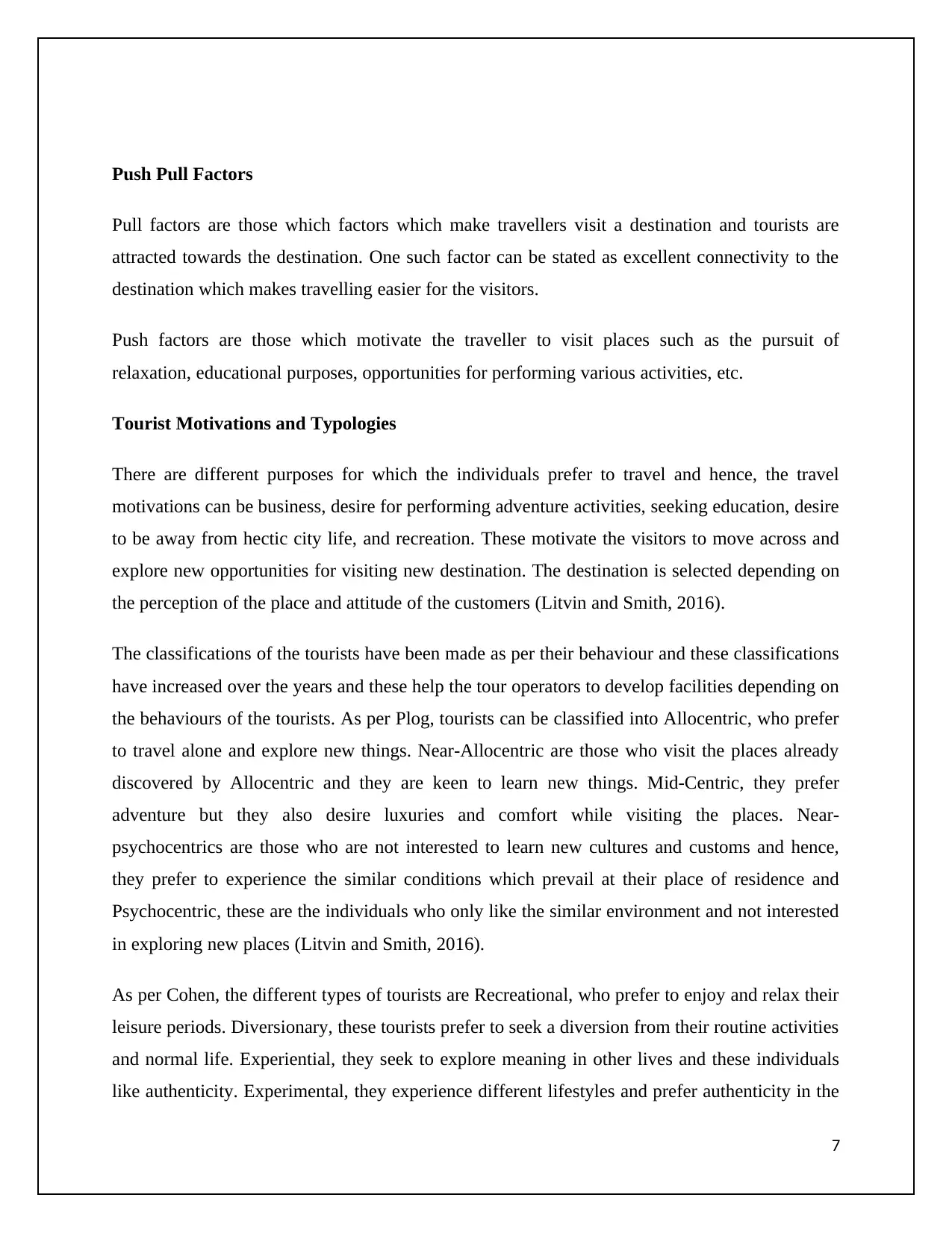
Push Pull Factors
Pull factors are those which factors which make travellers visit a destination and tourists are
attracted towards the destination. One such factor can be stated as excellent connectivity to the
destination which makes travelling easier for the visitors.
Push factors are those which motivate the traveller to visit places such as the pursuit of
relaxation, educational purposes, opportunities for performing various activities, etc.
Tourist Motivations and Typologies
There are different purposes for which the individuals prefer to travel and hence, the travel
motivations can be business, desire for performing adventure activities, seeking education, desire
to be away from hectic city life, and recreation. These motivate the visitors to move across and
explore new opportunities for visiting new destination. The destination is selected depending on
the perception of the place and attitude of the customers (Litvin and Smith, 2016).
The classifications of the tourists have been made as per their behaviour and these classifications
have increased over the years and these help the tour operators to develop facilities depending on
the behaviours of the tourists. As per Plog, tourists can be classified into Allocentric, who prefer
to travel alone and explore new things. Near-Allocentric are those who visit the places already
discovered by Allocentric and they are keen to learn new things. Mid-Centric, they prefer
adventure but they also desire luxuries and comfort while visiting the places. Near-
psychocentrics are those who are not interested to learn new cultures and customs and hence,
they prefer to experience the similar conditions which prevail at their place of residence and
Psychocentric, these are the individuals who only like the similar environment and not interested
in exploring new places (Litvin and Smith, 2016).
As per Cohen, the different types of tourists are Recreational, who prefer to enjoy and relax their
leisure periods. Diversionary, these tourists prefer to seek a diversion from their routine activities
and normal life. Experiential, they seek to explore meaning in other lives and these individuals
like authenticity. Experimental, they experience different lifestyles and prefer authenticity in the
7
Pull factors are those which factors which make travellers visit a destination and tourists are
attracted towards the destination. One such factor can be stated as excellent connectivity to the
destination which makes travelling easier for the visitors.
Push factors are those which motivate the traveller to visit places such as the pursuit of
relaxation, educational purposes, opportunities for performing various activities, etc.
Tourist Motivations and Typologies
There are different purposes for which the individuals prefer to travel and hence, the travel
motivations can be business, desire for performing adventure activities, seeking education, desire
to be away from hectic city life, and recreation. These motivate the visitors to move across and
explore new opportunities for visiting new destination. The destination is selected depending on
the perception of the place and attitude of the customers (Litvin and Smith, 2016).
The classifications of the tourists have been made as per their behaviour and these classifications
have increased over the years and these help the tour operators to develop facilities depending on
the behaviours of the tourists. As per Plog, tourists can be classified into Allocentric, who prefer
to travel alone and explore new things. Near-Allocentric are those who visit the places already
discovered by Allocentric and they are keen to learn new things. Mid-Centric, they prefer
adventure but they also desire luxuries and comfort while visiting the places. Near-
psychocentrics are those who are not interested to learn new cultures and customs and hence,
they prefer to experience the similar conditions which prevail at their place of residence and
Psychocentric, these are the individuals who only like the similar environment and not interested
in exploring new places (Litvin and Smith, 2016).
As per Cohen, the different types of tourists are Recreational, who prefer to enjoy and relax their
leisure periods. Diversionary, these tourists prefer to seek a diversion from their routine activities
and normal life. Experiential, they seek to explore meaning in other lives and these individuals
like authenticity. Experimental, they experience different lifestyles and prefer authenticity in the
7
Paraphrase This Document
Need a fresh take? Get an instant paraphrase of this document with our AI Paraphraser
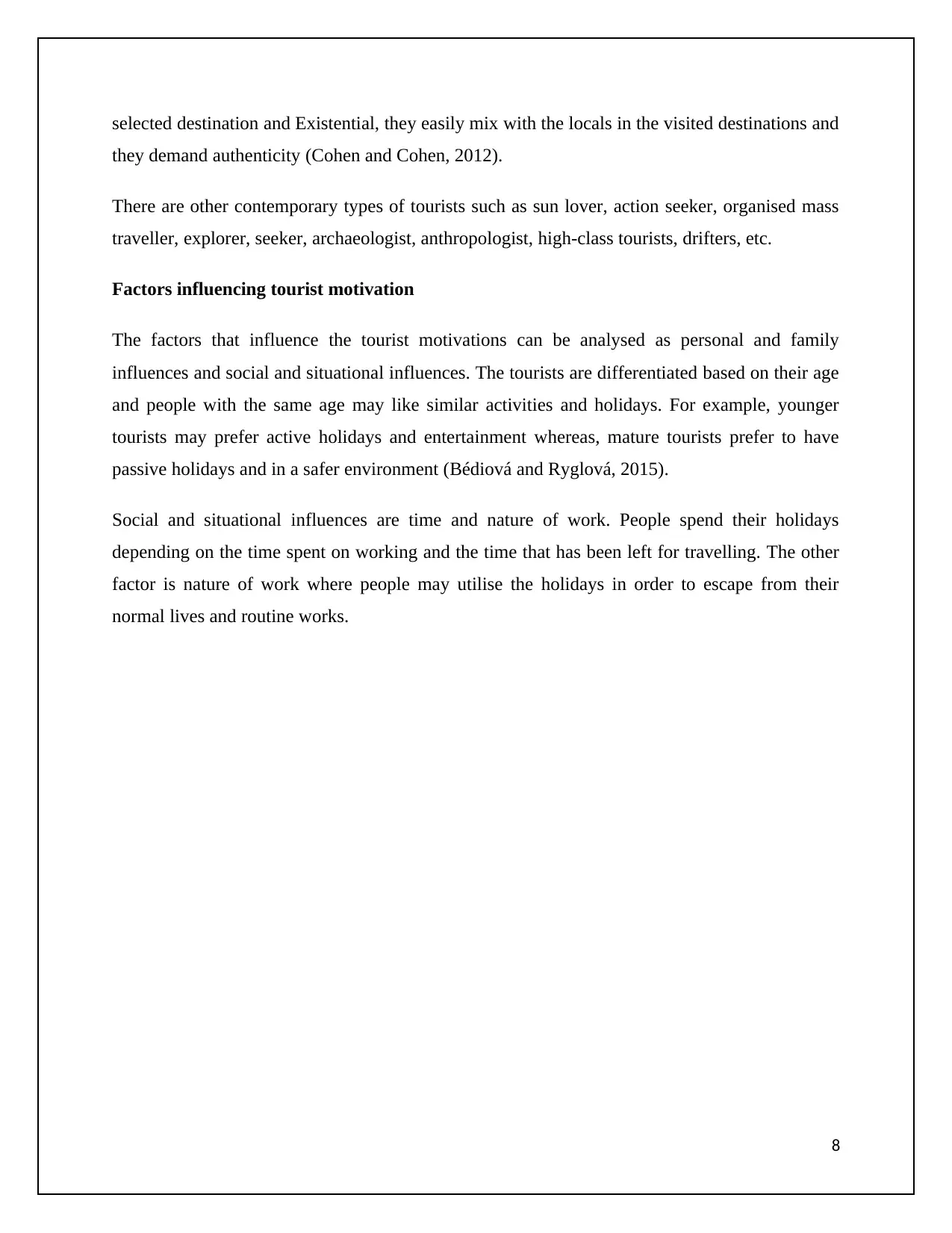
selected destination and Existential, they easily mix with the locals in the visited destinations and
they demand authenticity (Cohen and Cohen, 2012).
There are other contemporary types of tourists such as sun lover, action seeker, organised mass
traveller, explorer, seeker, archaeologist, anthropologist, high-class tourists, drifters, etc.
Factors influencing tourist motivation
The factors that influence the tourist motivations can be analysed as personal and family
influences and social and situational influences. The tourists are differentiated based on their age
and people with the same age may like similar activities and holidays. For example, younger
tourists may prefer active holidays and entertainment whereas, mature tourists prefer to have
passive holidays and in a safer environment (Bédiová and Ryglová, 2015).
Social and situational influences are time and nature of work. People spend their holidays
depending on the time spent on working and the time that has been left for travelling. The other
factor is nature of work where people may utilise the holidays in order to escape from their
normal lives and routine works.
8
they demand authenticity (Cohen and Cohen, 2012).
There are other contemporary types of tourists such as sun lover, action seeker, organised mass
traveller, explorer, seeker, archaeologist, anthropologist, high-class tourists, drifters, etc.
Factors influencing tourist motivation
The factors that influence the tourist motivations can be analysed as personal and family
influences and social and situational influences. The tourists are differentiated based on their age
and people with the same age may like similar activities and holidays. For example, younger
tourists may prefer active holidays and entertainment whereas, mature tourists prefer to have
passive holidays and in a safer environment (Bédiová and Ryglová, 2015).
Social and situational influences are time and nature of work. People spend their holidays
depending on the time spent on working and the time that has been left for travelling. The other
factor is nature of work where people may utilise the holidays in order to escape from their
normal lives and routine works.
8
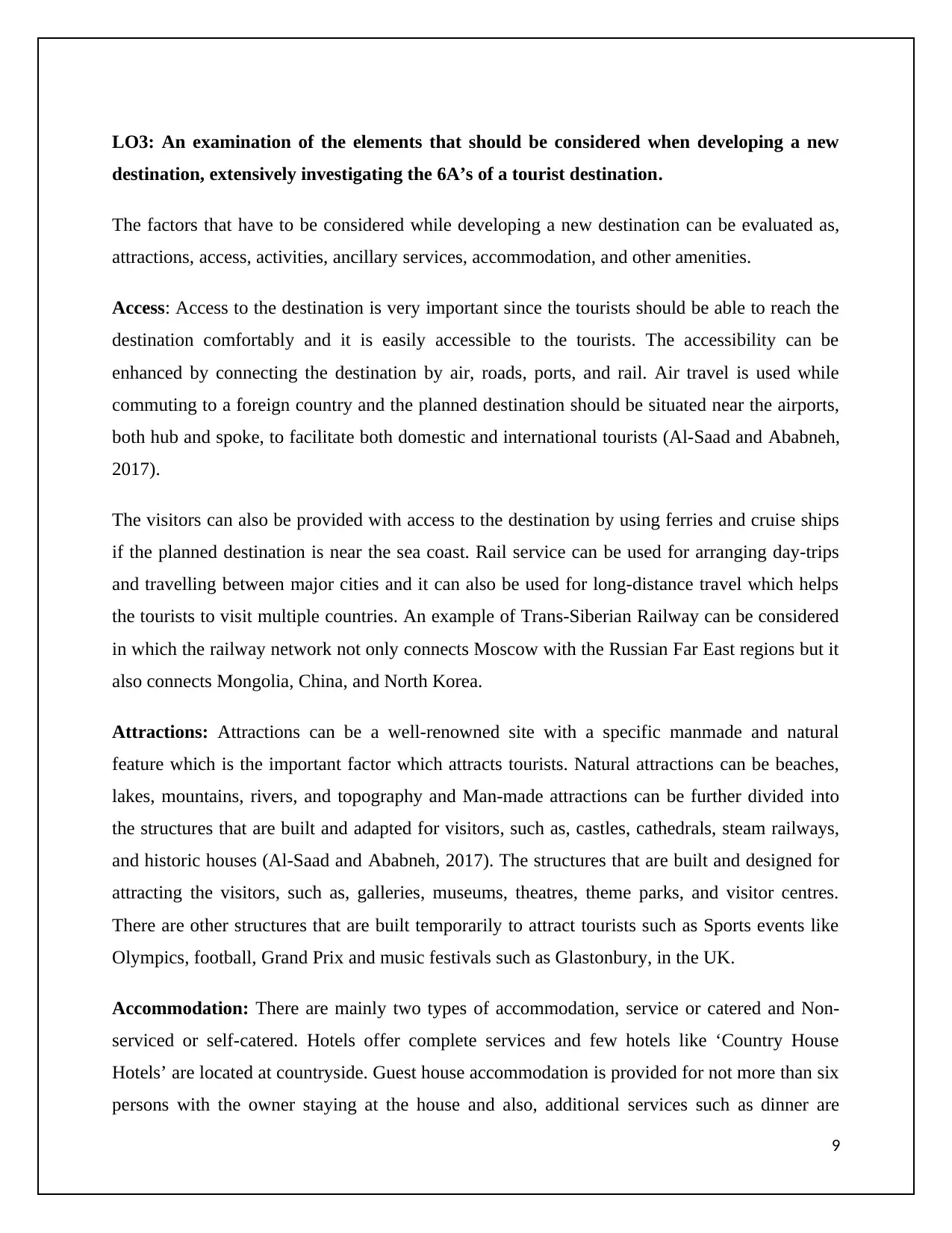
LO3: An examination of the elements that should be considered when developing a new
destination, extensively investigating the 6A’s of a tourist destination.
The factors that have to be considered while developing a new destination can be evaluated as,
attractions, access, activities, ancillary services, accommodation, and other amenities.
Access: Access to the destination is very important since the tourists should be able to reach the
destination comfortably and it is easily accessible to the tourists. The accessibility can be
enhanced by connecting the destination by air, roads, ports, and rail. Air travel is used while
commuting to a foreign country and the planned destination should be situated near the airports,
both hub and spoke, to facilitate both domestic and international tourists (Al-Saad and Ababneh,
2017).
The visitors can also be provided with access to the destination by using ferries and cruise ships
if the planned destination is near the sea coast. Rail service can be used for arranging day-trips
and travelling between major cities and it can also be used for long-distance travel which helps
the tourists to visit multiple countries. An example of Trans-Siberian Railway can be considered
in which the railway network not only connects Moscow with the Russian Far East regions but it
also connects Mongolia, China, and North Korea.
Attractions: Attractions can be a well-renowned site with a specific manmade and natural
feature which is the important factor which attracts tourists. Natural attractions can be beaches,
lakes, mountains, rivers, and topography and Man-made attractions can be further divided into
the structures that are built and adapted for visitors, such as, castles, cathedrals, steam railways,
and historic houses (Al-Saad and Ababneh, 2017). The structures that are built and designed for
attracting the visitors, such as, galleries, museums, theatres, theme parks, and visitor centres.
There are other structures that are built temporarily to attract tourists such as Sports events like
Olympics, football, Grand Prix and music festivals such as Glastonbury, in the UK.
Accommodation: There are mainly two types of accommodation, service or catered and Non-
serviced or self-catered. Hotels offer complete services and few hotels like ‘Country House
Hotels’ are located at countryside. Guest house accommodation is provided for not more than six
persons with the owner staying at the house and also, additional services such as dinner are
9
destination, extensively investigating the 6A’s of a tourist destination.
The factors that have to be considered while developing a new destination can be evaluated as,
attractions, access, activities, ancillary services, accommodation, and other amenities.
Access: Access to the destination is very important since the tourists should be able to reach the
destination comfortably and it is easily accessible to the tourists. The accessibility can be
enhanced by connecting the destination by air, roads, ports, and rail. Air travel is used while
commuting to a foreign country and the planned destination should be situated near the airports,
both hub and spoke, to facilitate both domestic and international tourists (Al-Saad and Ababneh,
2017).
The visitors can also be provided with access to the destination by using ferries and cruise ships
if the planned destination is near the sea coast. Rail service can be used for arranging day-trips
and travelling between major cities and it can also be used for long-distance travel which helps
the tourists to visit multiple countries. An example of Trans-Siberian Railway can be considered
in which the railway network not only connects Moscow with the Russian Far East regions but it
also connects Mongolia, China, and North Korea.
Attractions: Attractions can be a well-renowned site with a specific manmade and natural
feature which is the important factor which attracts tourists. Natural attractions can be beaches,
lakes, mountains, rivers, and topography and Man-made attractions can be further divided into
the structures that are built and adapted for visitors, such as, castles, cathedrals, steam railways,
and historic houses (Al-Saad and Ababneh, 2017). The structures that are built and designed for
attracting the visitors, such as, galleries, museums, theatres, theme parks, and visitor centres.
There are other structures that are built temporarily to attract tourists such as Sports events like
Olympics, football, Grand Prix and music festivals such as Glastonbury, in the UK.
Accommodation: There are mainly two types of accommodation, service or catered and Non-
serviced or self-catered. Hotels offer complete services and few hotels like ‘Country House
Hotels’ are located at countryside. Guest house accommodation is provided for not more than six
persons with the owner staying at the house and also, additional services such as dinner are
9
⊘ This is a preview!⊘
Do you want full access?
Subscribe today to unlock all pages.

Trusted by 1+ million students worldwide
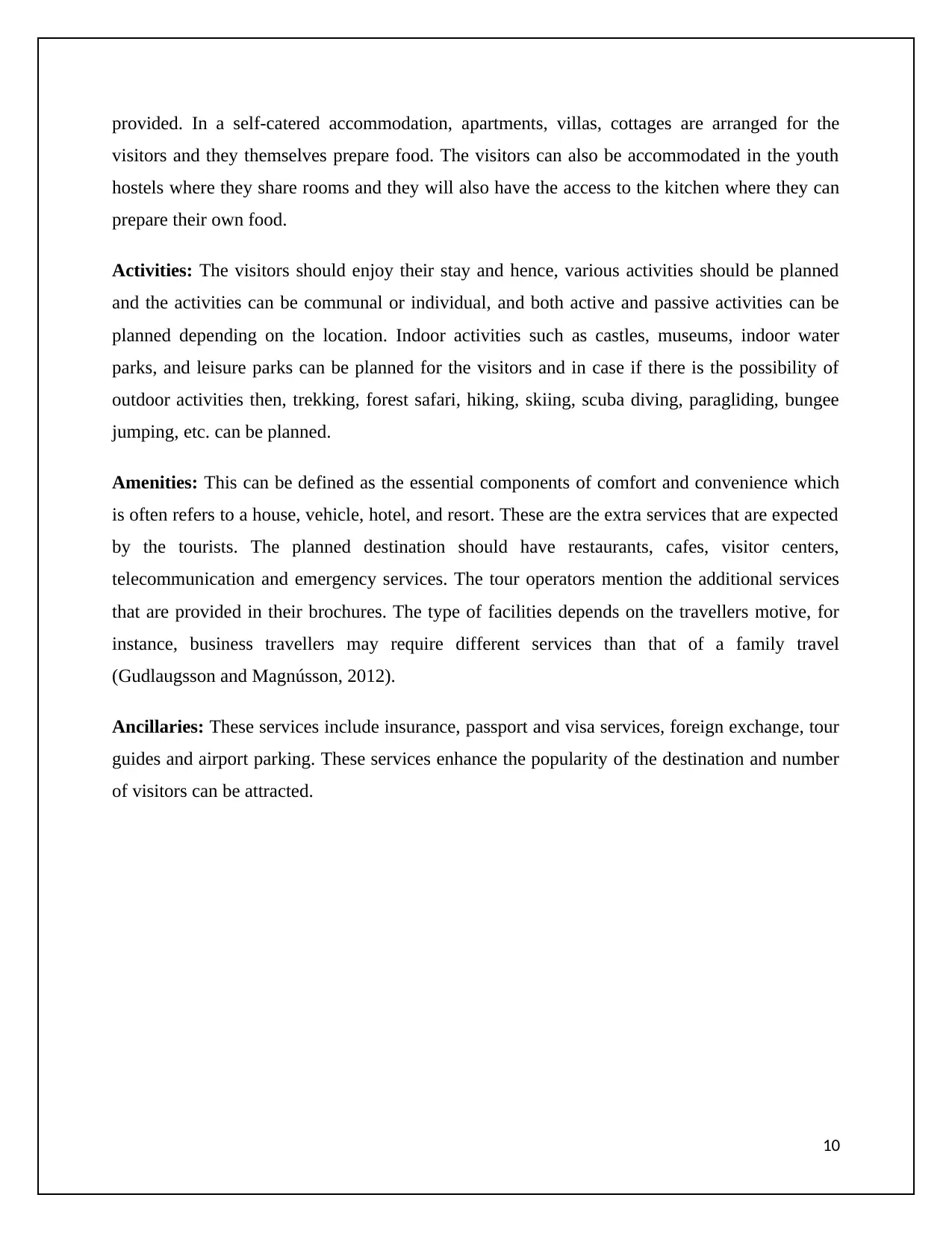
provided. In a self-catered accommodation, apartments, villas, cottages are arranged for the
visitors and they themselves prepare food. The visitors can also be accommodated in the youth
hostels where they share rooms and they will also have the access to the kitchen where they can
prepare their own food.
Activities: The visitors should enjoy their stay and hence, various activities should be planned
and the activities can be communal or individual, and both active and passive activities can be
planned depending on the location. Indoor activities such as castles, museums, indoor water
parks, and leisure parks can be planned for the visitors and in case if there is the possibility of
outdoor activities then, trekking, forest safari, hiking, skiing, scuba diving, paragliding, bungee
jumping, etc. can be planned.
Amenities: This can be defined as the essential components of comfort and convenience which
is often refers to a house, vehicle, hotel, and resort. These are the extra services that are expected
by the tourists. The planned destination should have restaurants, cafes, visitor centers,
telecommunication and emergency services. The tour operators mention the additional services
that are provided in their brochures. The type of facilities depends on the travellers motive, for
instance, business travellers may require different services than that of a family travel
(Gudlaugsson and Magnússon, 2012).
Ancillaries: These services include insurance, passport and visa services, foreign exchange, tour
guides and airport parking. These services enhance the popularity of the destination and number
of visitors can be attracted.
10
visitors and they themselves prepare food. The visitors can also be accommodated in the youth
hostels where they share rooms and they will also have the access to the kitchen where they can
prepare their own food.
Activities: The visitors should enjoy their stay and hence, various activities should be planned
and the activities can be communal or individual, and both active and passive activities can be
planned depending on the location. Indoor activities such as castles, museums, indoor water
parks, and leisure parks can be planned for the visitors and in case if there is the possibility of
outdoor activities then, trekking, forest safari, hiking, skiing, scuba diving, paragliding, bungee
jumping, etc. can be planned.
Amenities: This can be defined as the essential components of comfort and convenience which
is often refers to a house, vehicle, hotel, and resort. These are the extra services that are expected
by the tourists. The planned destination should have restaurants, cafes, visitor centers,
telecommunication and emergency services. The tour operators mention the additional services
that are provided in their brochures. The type of facilities depends on the travellers motive, for
instance, business travellers may require different services than that of a family travel
(Gudlaugsson and Magnússon, 2012).
Ancillaries: These services include insurance, passport and visa services, foreign exchange, tour
guides and airport parking. These services enhance the popularity of the destination and number
of visitors can be attracted.
10
Paraphrase This Document
Need a fresh take? Get an instant paraphrase of this document with our AI Paraphraser
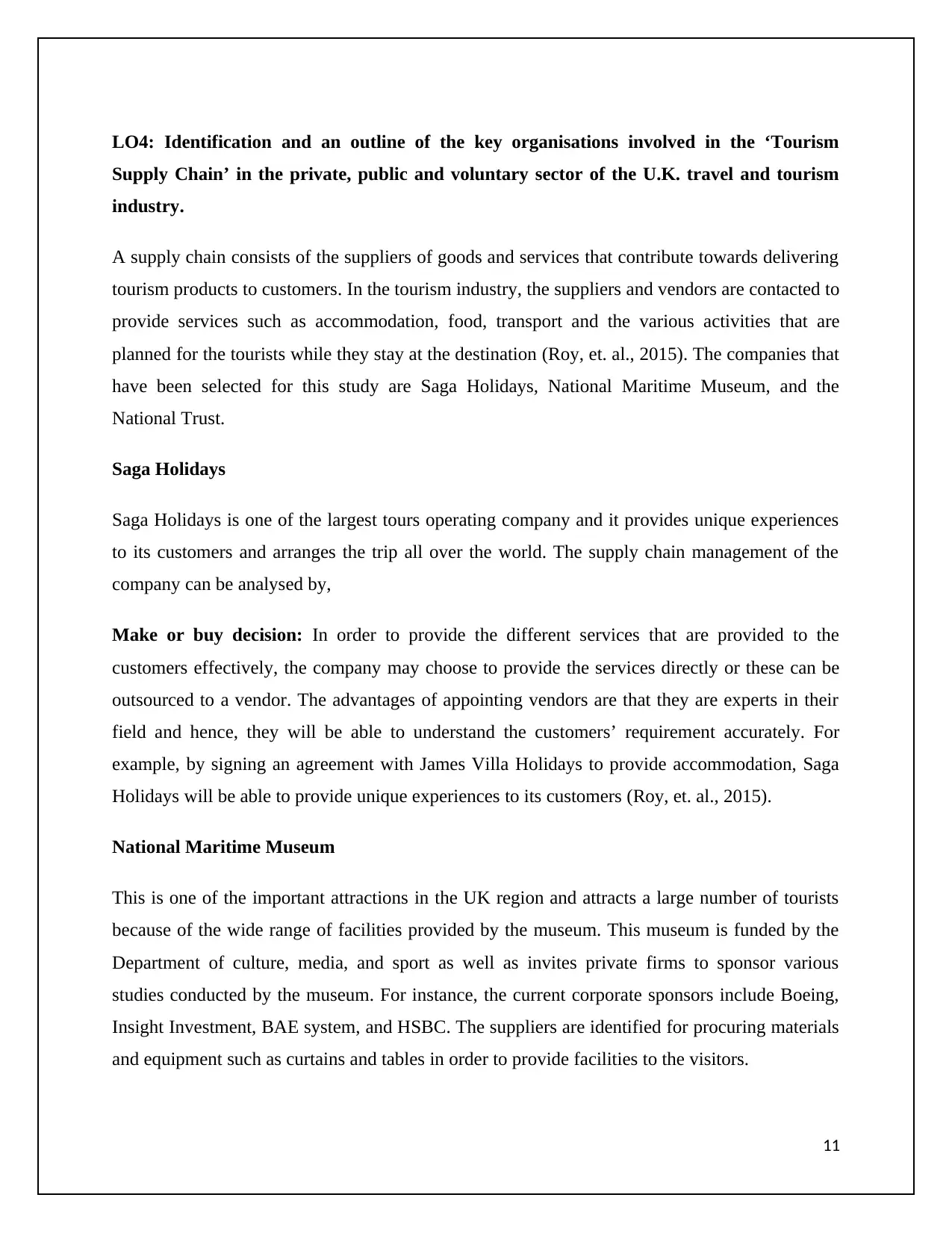
LO4: Identification and an outline of the key organisations involved in the ‘Tourism
Supply Chain’ in the private, public and voluntary sector of the U.K. travel and tourism
industry.
A supply chain consists of the suppliers of goods and services that contribute towards delivering
tourism products to customers. In the tourism industry, the suppliers and vendors are contacted to
provide services such as accommodation, food, transport and the various activities that are
planned for the tourists while they stay at the destination (Roy, et. al., 2015). The companies that
have been selected for this study are Saga Holidays, National Maritime Museum, and the
National Trust.
Saga Holidays
Saga Holidays is one of the largest tours operating company and it provides unique experiences
to its customers and arranges the trip all over the world. The supply chain management of the
company can be analysed by,
Make or buy decision: In order to provide the different services that are provided to the
customers effectively, the company may choose to provide the services directly or these can be
outsourced to a vendor. The advantages of appointing vendors are that they are experts in their
field and hence, they will be able to understand the customers’ requirement accurately. For
example, by signing an agreement with James Villa Holidays to provide accommodation, Saga
Holidays will be able to provide unique experiences to its customers (Roy, et. al., 2015).
National Maritime Museum
This is one of the important attractions in the UK region and attracts a large number of tourists
because of the wide range of facilities provided by the museum. This museum is funded by the
Department of culture, media, and sport as well as invites private firms to sponsor various
studies conducted by the museum. For instance, the current corporate sponsors include Boeing,
Insight Investment, BAE system, and HSBC. The suppliers are identified for procuring materials
and equipment such as curtains and tables in order to provide facilities to the visitors.
11
Supply Chain’ in the private, public and voluntary sector of the U.K. travel and tourism
industry.
A supply chain consists of the suppliers of goods and services that contribute towards delivering
tourism products to customers. In the tourism industry, the suppliers and vendors are contacted to
provide services such as accommodation, food, transport and the various activities that are
planned for the tourists while they stay at the destination (Roy, et. al., 2015). The companies that
have been selected for this study are Saga Holidays, National Maritime Museum, and the
National Trust.
Saga Holidays
Saga Holidays is one of the largest tours operating company and it provides unique experiences
to its customers and arranges the trip all over the world. The supply chain management of the
company can be analysed by,
Make or buy decision: In order to provide the different services that are provided to the
customers effectively, the company may choose to provide the services directly or these can be
outsourced to a vendor. The advantages of appointing vendors are that they are experts in their
field and hence, they will be able to understand the customers’ requirement accurately. For
example, by signing an agreement with James Villa Holidays to provide accommodation, Saga
Holidays will be able to provide unique experiences to its customers (Roy, et. al., 2015).
National Maritime Museum
This is one of the important attractions in the UK region and attracts a large number of tourists
because of the wide range of facilities provided by the museum. This museum is funded by the
Department of culture, media, and sport as well as invites private firms to sponsor various
studies conducted by the museum. For instance, the current corporate sponsors include Boeing,
Insight Investment, BAE system, and HSBC. The suppliers are identified for procuring materials
and equipment such as curtains and tables in order to provide facilities to the visitors.
11
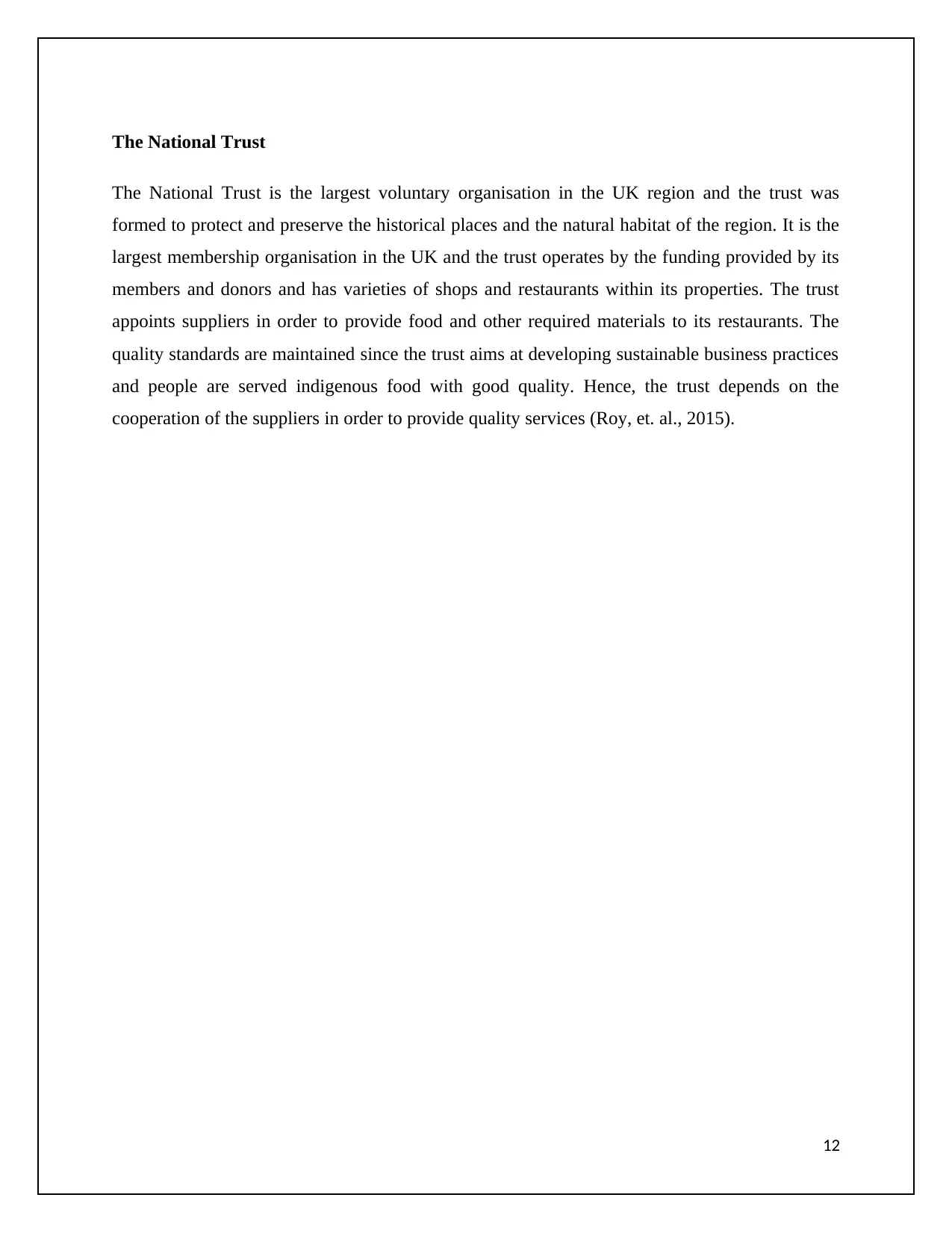
The National Trust
The National Trust is the largest voluntary organisation in the UK region and the trust was
formed to protect and preserve the historical places and the natural habitat of the region. It is the
largest membership organisation in the UK and the trust operates by the funding provided by its
members and donors and has varieties of shops and restaurants within its properties. The trust
appoints suppliers in order to provide food and other required materials to its restaurants. The
quality standards are maintained since the trust aims at developing sustainable business practices
and people are served indigenous food with good quality. Hence, the trust depends on the
cooperation of the suppliers in order to provide quality services (Roy, et. al., 2015).
12
The National Trust is the largest voluntary organisation in the UK region and the trust was
formed to protect and preserve the historical places and the natural habitat of the region. It is the
largest membership organisation in the UK and the trust operates by the funding provided by its
members and donors and has varieties of shops and restaurants within its properties. The trust
appoints suppliers in order to provide food and other required materials to its restaurants. The
quality standards are maintained since the trust aims at developing sustainable business practices
and people are served indigenous food with good quality. Hence, the trust depends on the
cooperation of the suppliers in order to provide quality services (Roy, et. al., 2015).
12
⊘ This is a preview!⊘
Do you want full access?
Subscribe today to unlock all pages.

Trusted by 1+ million students worldwide
1 out of 14
Related Documents
Your All-in-One AI-Powered Toolkit for Academic Success.
+13062052269
info@desklib.com
Available 24*7 on WhatsApp / Email
![[object Object]](/_next/static/media/star-bottom.7253800d.svg)
Unlock your academic potential
Copyright © 2020–2025 A2Z Services. All Rights Reserved. Developed and managed by ZUCOL.





